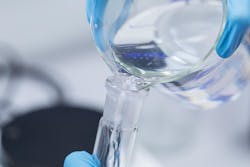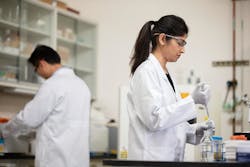Per- and polyfluoroalkyl substances (PFAS) are some of the most far-reaching man-made chemicals in the world today, permeating our daily existence in everything from non-stick cookware to takeout containers.
Nothing about PFAS — from how they are made to their impermeable nature to how they need to be analyzed — is easy. The irony is unmistakable: we developed these chemicals to simplify our lives only to be haunted by their elusive and difficult nature decades later, and it’s a serious problem. A few things are known for certain — how the compound works, what its limitations are, and that PFAS contamination is an environmental and growing health issue. What is less clear is how to address this issue and manage it in a way that leaves the environment unmarked.
In this Q&A round table, scientists from around the globe share their perspectives on current research and technological advances being used to address these forever chemicals.
The Scientists
James Dodds is post-doctoral student at North Carolina State University. Erin Baker is an associate professor at North Carolina State University. Together, Dodds and Baker’s work focuses on utilizing new analytical techniques such as ion mobility spectrometry (IMS) for detecting and characterizing PFAS isomers and newly observed PFAS compounds. While most PFAS studies are currently performed using traditional LC-MS approaches for known compounds, IMS separations provide a novel way of analyzing and identifying the many new features occurring in untargeted PFAS sample analyses.
Detlef Knappe is a professor at North Carolina State University who advises students and postdoctoral researchers focused on a wide range of topics, including the development of targeted and non-targeted analytical methods for PFAS in water, biological samples, and soil; the development of tailored sorbents for the selective removal of PFAS from water; and the assessment of readily implementable water treatment technologies.
Bradley Clarke is a senior lecturer in analytical chemistry and environmental science at the University of Melbourne, Australia. His work focuses on the environmental sources, fate, and impact of PFAS on public health and the environment.
Christian Zwiener is a professor of environmental and analytical chemistry at Eberhard Karls Universität Tübingen, Germany, interested in PFAS used for paper and cardboard impregnation and their transformation products. Currently, his focus is on fluorotelomer-based phosphate diesters (diPAPs) and sulfonamide ethanol-based phosphate diesters (diSAmPAPs). Further high-resolution mass spectrometry (HRMS) screening is applied to identify further products and especially transformation products due to environmental processes.
Jun Huang is an associate professor at Tsinghua University, China. Gang Yu is a professor at Tsinghua University, China. Their combined work interest is in the area of PFAS emission from main industrial sectors; PFAS contamination in hot spots and its risk assessment; and PFAS degradation mechanism by advanced oxidation/reduction processes.
Q: Why is concern growing regarding PFAS?
James Dodds and Erin Baker: PFAS exposure has been linked to various adverse health outcomes such as thyroid disease, testicular cancer, kidney cancer, and pregnancy-induced hypertension. Thus, with each potential environmental spill or release, public health concerns rise further about PFAS, particularly with regard to drinking water safety.
Detlef Knappe: PFAS are of concern because many are persistent, bioaccumulative, and toxic. PFAS readily bind to proteins in blood and are transported throughout the body. As a result, they are potentially associated with a wide range of adverse health outcomes, including decreased immune function, cancer, elevated cholesterol, and ulcerative colitis, among others.
Also, the human body is not effective at eliminating PFAS, and half-lives of some PFAS in humans, such as perfluorohexane sulfonic acid, can exceed five years. Therefore, PFAS can accumulate in the body even when levels in drinking water are low. As a result, drinking water standards and health advisory levels are being set at low ng/L levels. For instance, the state of New Jersey promulgated a standard of 13 ng/L for perfluorononanoic acid (PFNA).
Another reason for concern is the fear of the unknown. The PFAS class contains thousands of compounds, but we currently lack fully appropriate analytical methods and information about the toxicity for most. As a result, people may wonder which PFAS compounds they might have been exposed to and what the potential health effects could be.
For example, in Wilmington, N.C., people drank water containing PFAS at levels on the order of 100,000 ng/L, likely for more than 35 years. The PFAS that were present in greatest abundance were first identified in 2015, and no information about their toxicity is available to date.
Bradley Clarke: The unique chemical properties that make PFAS so valuable for modern applications are often the very same that make PFAS incredibly problematic in the environment. First-generation persistent organic pollutants (POPs) were pretty bad, but we could largely predict how they would behave in the environment. PFAS are a new style of pollutant that don’t follow the ‘rules’ of traditional organic pollutants.
This is why regulators and scientists unfortunately failed to predict how these chemicals would move through the environment, and why we now have a serious problem of such widespread PFAS contamination of drinking water, agricultural land, and the domestic environment. Furthermore, we are only really just beginning to characterize the health impacts of a chemical that is ubiquitously present throughout the built and natural environment.
Christian Zwiener: PFAS products have built up a particularly large but not well characterized reservoir in contaminated soils, which is slowly attenuated by natural processes. The transformation products such as the perfluorinated carboxylic acids (PFCAs) are more mobile in water/soil systems than their precursors. This is strongly correlated with the carbon chain length. Hence, mainly short-chain PFCAs have been found in groundwater samples and in green, and partly within edible, parts of field crops. Both drinking water and field crops are sources for human exposure, which has to be minimized.
Jun Huang and Gang Yu: PFAS are extremely stable and persistent in the ambient environment, but can easily enter into water bodies. Public concerns have been aroused about drinking water safety [as a result of] PFAS.
In China, currently there is no regulatory limit for emission or water quality criteria for PFAS, and advanced treatment has not been widely adopted in drinking water plants. As such, these concerns are reasonable and necessary to clarify.
Q: Why is it important to be able to measure PFAS compounds at such low levels? What technology is assisting you in doing this?
James Dodds and Erin Baker: The U.S. Environmental Protection Agency (and other international health agencies) are releasing advisory limits for PFAS exposure, particularly as it relates to drinking water standards. Since PFAS bioaccumulate, even small doses throughout time can cause these compounds to build up to toxic levels. As a consequence, the advised concentration levels for these analytes are extremely low (ppb and ppt levels). Due to their low limits of detection and a high degree of selectivity, mass spectrometer platforms coupled with liquid chromatography are quickly becoming necessary analytical equipment for analyzing the presence of PFAS.
Detlef Knappe: Many PFAS are bioaccumulative, meaning that exposure to PFAS at part-per-trillion levels in drinking water can lead to significantly elevated PFAS levels in blood serum. To prevent adverse health outcomes, it is therefore important to remove low levels of PFAS from drinking water. Advances in liquid chromatography and mass spectrometry, such as online solid-phase extraction and high-efficiency ion sources, enable us to determine PFAS concentrations in the sub-ng/L to low ng/L range while maintaining high throughput.
Bradley Clarke: People talk about concentrations of 1 ng/L or 1 ng/mL of blood as if these are insignificant amounts of chemicals. While it is true that this is a very low level near the lower limits of our analytical capability, the fact is that at these concentrations, there are still trillions of PFAS molecules in every single milliliter of water and more frighteningly in our blood. The best way to measure PFAS is with LC/TQ (liquid chromatography/triple quadrupole) using isotope dilution.
Jun Huang and Gang Yu: The detected concentrations of PFAS in surface or groundwater are typically at the level of ng/L. Also, the health advisory values from the U.S. EPA or other agencies are also at this level. Therefore, it is very important to ensure the MDL be compatible with such requirements. In our lab, we mainly use ultra-high-performance liquid chromatography-tandem mass spectrometry (UHPLC-MS/MS) to determine PFAS in environmental samples. EPA method 537.1 and TOP assay are normally used in our lab.
Q: What future analytical or technological capabilities do you think are required to continue this momentum in PFAS research?
James Dodds and Erin Baker: The current limitation and hold-up for rapid PFAS analysis is the pre-concentration step that usually requires the concentration of milliliter amounts of sample for a single measurement to achieve the low limits of detection required for routine PFAS screening. Various instrument vendors are offering a wide range of devices to help in this effort, but due to the numerous analyses needed, this additional time and sample amount causes challenges in rapid sample throughput. Furthermore, typical LC methods used for PFAS studies are also lengthy (often >10 min) and low throughput, especially when there are so many potential sites of contamination that need routine screening to ensure safe drinking water.
Detlef Knappe: Because of the many research questions we are focusing on, our biggest obstacle is throughput. I believe throughput is also a big issue in other research and commercial labs. Rate-limiting steps in terms of throughput include sample preparation and the time required to achieve sufficient chromatographic separation when targeting a large number of PFAS. Technology, such as the RapidFire, combined with Ion Mobility separation, could dramatically increase throughput if sufficient sensitivity could be obtained. Such capabilities would allow us to more quickly answer important research questions as well as questions of residents in impacted communities.
Bradley Clarke: There are two main areas where analytical chemistry must improve. The first is related to untargeted analysis. Currently, we build analytical methods to measure what we think is present in the environment. This is a slow and expensive process that must be improved. We need to have the capability to determine all the synthetic chemicals that are in an environmental sample. It is likely that advances in time-of-flight mass spectrometry combined with increased data processing power will allow us to move in this direction. This is critically important, as we currently only analyze a small handful of the thousands of identified PFAS.
Jun Huang and Gang Yu: We plan to strengthen two analytical capacities: (1) Non-target analysis of PFAS using LC-HRMS, e.g., TOFMS; (2) Determination of total organic fluorine by combustion ion chromatography (CIC). WW
About the Author: Tarun Anumol is the global environment market manager for Agilent Technologies. Previously, he was an LC-MS applications scientist at Agilent, focused on developing analytical methods for trace contaminants on LC-MS/MS and LC-Q/TOF in environmental and food matrices. Anumol has a strong history of working in the environmental testing industry, with a background in technical and applied science, with experience in water treatment, environmental monitoring, and advanced analytical chemistry. He graduated with a Ph.D. in chemical and environmental engineering from the University of Arizona with a focus on water treatment strategies for water reuse and identification of emerging contaminants in the environment. He holds an MS in civil and environmental engineering from Carnegie Mellon University and a BS in chemical engineering.
About the Author
Tarun Anumol
Tarun Anumol is the global environment market manager for Agilent Technologies. Previously, he was an LC-MS applications scientist at Agilent, focused on developing analytical methods for trace contaminants on LC-MS/MS and LC-Q/TOF in environmental and food matrices. Anumol has a strong history of working in the environmental testing industry, with a background in technical and applied science, with experience in water treatment, environmental monitoring, and advanced analytical chemistry. He graduated with a Ph.D. in chemical and environmental engineering from the University of Arizona with a focus on water treatment strategies for water reuse and identification of emerging contaminants in the environment. He holds an MS in civil and environmental engineering from Carnegie Mellon University and a BS in chemical engineering.




